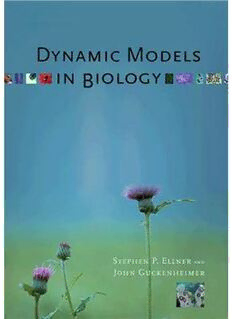
Dynamic Models in Biology PDF
Preview Dynamic Models in Biology
Dynamic Models in Biology DYNAMIC MODELS IN BIOLOGY Stephen P. Ellner and John Guckenheimer ©2006 by Princeton University Press Published by Princeton University Press, 41 William Street, Princeton, New Jersey 08540 In the United Kingdom: Princeton University Press, 3 Market Place, Woodstock, Oxfordshire OX20 1SY All Rights Reserved Library of Congress Cataloging-in-Publication Data Ellner, Stephen P., 1953– Dynamic models in biology / Stephen P. Ellner and John Guckenheimer. p. cm. Includes bibliographical references and index. ISBN-13: 978-0-691-11843-7 (alk. paper) ISBN-10: 0-691-11843-4 (alk. paper) ISBN-13: 978-0-691-12589-3 (pbk. : alk. paper) ISBN-10: 0-691-12589-9 (pbk. : alk. paper) 1. Biology–Mathematical models. I. Guckenheimer, John. II. Title QH323.5.E44 2006 570′.1′5118–dc22 2005048818 British Library Cataloging-in-Publication Data is available This book has been composed in Stone and Stone Sans Printed on acid-free paper. ∞ pup.princeton.edu Printed in the United States of America 10 9 8 7 6 5 4 3 2 1 Contents List of Figures List of Tables Preface 1 What Are Dynamic Models? 1.1 Descriptive versus Mechanistic Models 1.2 Chinook Salmon 1.3 Bathtub Models 1.4 Many Bathtubs: Compartment Models 1.4.1 Enzyme Kinetics 1.4.2 The Modeling Process 1.4.3 Pharmacokinetic Models 1.5 Physics Models: Running and Hopping 1.6 Optimization Models 1.7 Why Bother? 1.8 Theoretical versus Practical Models 1.9 What’s Next? 1.10 References 2 Matrix Models and Structured Population Dynamics 2.1 The Population Balance Law 2.2 Age-Structured Models 2.2.1 The Leslie Matrix 2.2.2 Warning: Prebreeding versus Postbreeding Models 2.3 Matrix Models Based on Stage Classes 2.4 Matrices and Matrix Operations 2.4.1 Review of Matrix Operations 2.4.2 Solution of the Matrix Model 2.5 Eigenvalues and a Second Solution of the Model 2.5.1 Left Eigenvectors 2.6 Some Applications of Matrix Models 2.6.1 Why Do We Age? 2.6.2 Elasticity Analysis and Conservation Biology 2.6.3 How Much Should We Trust These Models? 2.7 Generalizing the Matrix Model 2.7.1 Stochastic Matrix Models 2.7.2 Density-Dependent Matrix Models 2.7.3 Continuous Size Distributions 2.8 Summary and Conclusions 2.9 Appendix 2.9.1 Existence and Number of Eigenvalues 2.9.2 Reproductive Value 2.10 References 3 Membrane Channels and Action Potentials 3.1 Membrane Currents 3.1.1 Channel Gating and Conformational States 3.2 Markov Chains 3.2.1 Coin Tossing 3.2.2 Markov Chains 3.2.3 The Neuromuscular Junction 3.3 Voltage-Gated Channels 3.4 Membranes as Electrical Circuits 3.4.1 Reversal Potential 3.4.2 Action Potentials 3.5 Summary 3.6 Appendix: The Central Limit Theorem 3.7 References 4 Cellular Dynamics: Pathways of Gene Expression 4.1 Biological Background 4.2 A Gene Network That Acts as a Clock 4.2.1 Formulating a Model 4.2.2 Model Predictions 4.3 Networks That Act as a Switch 4.4 Systems Biology 4.4.1 Complex versus Simple Models 4.5 Summary 4.6 References 5 Dynamical Systems 5.1 Geometry of a Single Differential Equation 5.2 Mathematical Foundations: A Fundamental Theorem 5.3 Linearization and Linear Systems 5.3.1 Equilibrium Points 5.3.2 Linearization at Equilibria 5.3.3 Solving Linear Systems of Differential Equations 5.3.4 Invariant Manifolds 5.3.5 Periodic Orbits 5.4 Phase Planes 5.5 An Example: The Morris-Lecar Model 5.6 Bifurcations 5.7 Numerical Methods 5.8 Summary 5.9 References 6 Differential Equation Models for Infectious Disease 6.1 Sir Ronald Ross and the Epidemic Curve 6.2 Rescaling the Model 6.3 Endemic Diseases and Oscillations 6.3.1 Analysis of the SIR Model with Births 6.3.2 Summing Up 6.4 Gonorrhea Dynamics and Control 6.4.1 A Simple Model and a Paradox 6.4.2 The Core Group 6.4.3 Implications for Control 6.5 Drug Resistance 6.6 Within-Host Dynamics of HIV 6.7 Conclusions 6.8 References 7 Spatial Patterns in Biology 7.1 Reaction-Diffusion Models 7.2 The Turing Mechanism 7.3 Pattern Selection: Steady Patterns 7.4 Moving Patterns: Chemical Waves and Heartbeats 7.5 References 8 Agent-Based and Other Computational Models for Complex Systems 8.1 Individual-Based Models in Ecology 8.1.1 Size-Dependent Predation 8.1.2 Swarm 8.1.3 Individual-Based Modeling of Extinction Risk 8.2 Artificial Life 8.2.1 Tierra 8.2.2 Microbes in Tierra 8.2.3 Avida 8.3 The Immune System and the Flu 8.4 What Can We Learn from Agent-Based Models? 8.5 Sensitivity Analysis 8.5.1 Correlation Methods 8.5.2 Variance Decomposition 8.6 Simplifying Computational Models 8.6.1 Separation of Time Scales 8.6.2 Simplifying Spatial Models 8.6.3 Improving the Mean Field Approximation 8.7 Conclusions 8.8 Appendix: Derivation of Pair Approximation 8.9 References 9 Building Dynamic Models 9.1 Setting the Objective 9.2 Building an Initial Model 9.2.1 Conceptual Model and Diagram 9.3 Developing Equations for Process Rates 9.3.1 Linear Rates: When and Why? 9.3.2 Nonlinear Rates from “First Principles” 9.3.3 Nonlinear Rates from Data: Fitting Parametric Models 9.3.4 Nonlinear Rates from Data: Selecting a Parametric Model 9.4 Nonlinear Rates from Data: Nonparametric Models 9.4.1 Multivariate Rate Equations 9.5 Stochastic Models 9.5.1 Individual-Level Stochasticity 9.5.2 Parameter Drift and Exogenous Shocks 9.6 Fitting Rate Equations by Calibration 9.7 Three Commandments for Modelers 9.8 Evaluating a Model 9.8.1 Comparing Models 9.9 References Index List of Figures Figure 1.1. Decline in Coho salmon stocks on the Thomson River, BC Figure 1.2. Rate of decline on individual streams related to habitat variables Figure 1.3. Frequency distribution of recruits per spawner for the Bear, Marsh, and Sulphur Creek stocks of Chinook salmon Figure 1.4. Compartment diagram of the bathtub model Figure 1.5. Data on the rate of hydrolysis of sucrose by invertase fitted to the Michaelis-Menten equation Figure 1.6. Compartment diagram for the enzyme-mediated biochemical reaction Figure 1.7. Graphical analysis of dv/dt = k s − (k + k + k s)v 1 −1 2 1 Figure 1.8. Compartment model for arsenic in rat hepatocytes Figure 1.9. Compartment diagram for the IEUBK model for lead in children Figure 1.10. A cartoon of the pogo stick or monopode Figure 1.11. The monopode in stance phase Figure 1.12. Diagram of the experimental fishpond system showing water flows between compartments Figure 1.13. Compartment diagrams for Exercise 1.3 Figure 2.1. The standard size-class model Figure 2.2. Stage-structured model for killer whales Figure 2.3. Eigenvalue elasticities for stage-structured model for desert tortoise Figure 2.4. Eigenvalue elasticities for stage-structured model for loggerhead sea turtles Figure 2.5. The LPA model Figure 2.6. Eigenvalue elasticities for matrix models of northern monkshood using two different size populations Figure 2.7. Elasticity surface for the integral projection model for northern monkshood
